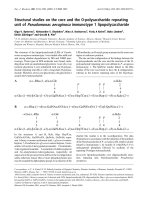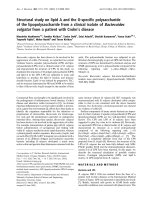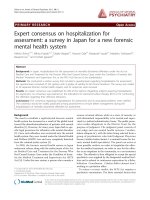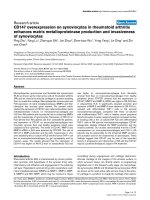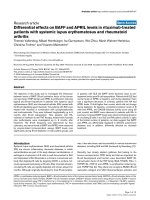Báo cáo y học: "Spontaneous hypothermia on intensive care unit admission is a predictor of unfavorable neurological outcome in patients after resuscitation: an observational cohort study" pptx
Bạn đang xem bản rút gọn của tài liệu. Xem và tải ngay bản đầy đủ của tài liệu tại đây (343.9 KB, 5 trang )
den Hartog et al. Critical Care 2010, 14:R121
/>Open Access
RESEARCH
© 2010 den Hartog et al.; licensee BioMed Central Ltd. This is an open access article distributed under the terms of the Creative Com-
mons Attribution License ( which permits unrestricted use, distribution, and reproduc-
tion in any medium, provided the original work is properly cited.
Research
Spontaneous hypothermia on intensive care unit
admission is a predictor of unfavorable
neurological outcome in patients after
resuscitation: an observational cohort study
Alexander W den Hartog
1
, Anne-Cornélie JM de Pont*
1
, Laure BM Robillard
1
, Jan M Binnekade
1
, Marcus J Schultz
2
and Janneke Horn
1
Abstract
Introduction: A large number of patients resuscitated for primary cardiac arrest arrive in the intensive care unit (ICU)
with a body temperature < 35.0°C. The aim of this observational cohort study was to determine the association
between ICU admission temperature and neurological outcome in this patient group.
Methods: Demographics and parameters influencing neurological outcome were retrieved from the charts of all
patients resuscitated for primary cardiac arrest and treated with induced mild hypothermia in our ICU from January
2006 until January 2008. Patients were divided into two groups according to their body temperature on ICU admission:
a hypothermia group (< 35.0°C) and a non-hypothermia group (≥35.0°C). Neurological outcome after six months was
assessed by means of the Glasgow Outcome Score (GOS), with GOS 1 to 3 defined as unfavorable and GOS 4 to 5 as
favorable. A logistic regression model was used to analyze the influence of the different parameters on neurological
outcome.
Results: The data of 105 consecutive patients resuscitated for primary cardiac arrest and treated with induced mild
hypothermia were analyzed. Median ICU admission temperature was 35.1°C (interquartile range (IQR) 34.3 to 35.7).
After six months, 61% of the patients had an unfavorable outcome (59% died and 2% were severely disabled), whereas
39% had a favorable outcome (moderate disability or good recovery). Among patients with spontaneous hypothermia
on ICU admission, the percentage with unfavorable outcome was higher (69% versus 50%, P = 0.05). Logistic regression
showed that age, acute physiology and chronic health evaluation (APACHE) II and sequential organ failure assessment
(SOFA) scores and spontaneous hypothermia on ICU admission all had an increased odds ratio (OR) for an unfavorable
outcome after six months. Spontaneous hypothermia had the strongest association with unfavorable outcome (OR 2.6,
95% CI (confidence interval) 1.1 to 5.9), which became even stronger after adjustment for age, presenting heart
rhythm, APACHE II and SOFA scores (OR 3.8, CI 1.3 to 11.0).
Conclusions: In this observational cohort study, spontaneous hypothermia on ICU admission was the strongest
predictor of an unfavorable neurological outcome in patients resuscitated for primary cardiac arrest.
Introduction
A large number of patients resuscitated for cardiac arrest
arrive in the intensive care unit (ICU) with hypothermia.
Since two prospective randomized multicenter trials
demonstrated a beneficial effect of induced mild hypo-
thermia on neurological outcome after cardiac arrest
[1,2], one could argue that patients with spontaneous
hypothermia on ICU admission might have a better out-
come, since the time needed to reach the target body
temperature during induced mild hypothermia is
reduced. On the other hand, spontaneous hypothermia
could be a sign of impaired thermoregulation and thus be
* Correspondence:
1
Department of Intensive Care Medicine, Academic Medical Center, University
of Amsterdam, Meibergdreef 9, Amsterdam, 1105 AZ, The Netherlands
Full list of author information is available at the end of the article
den Hartog et al. Critical Care 2010, 14:R121
/>Page 2 of 5
related to an unfavorable outcome. The aim of the cur-
rent study was to analyze whether spontaneous hypo-
thermia on ICU admission was a predictor of
neurological outcome in patients resuscitated for primary
cardiac arrest.
Materials and methods
Study design
We performed an observational cohort study based on
stored data from patients treated in our ICU in 2006 and
2007. The institutional review board approved the study
and since no intervention was performed, the need for
informed consent was waived.
Study population and data sources
Data from all consecutive patients resuscitated for car-
diac arrest and treated with induced mild hypothermia in
our 28-bed mixed medical-surgical ICU between 1 Janu-
ary 2006 and 1 January 2008 were retrieved from our
Patient Data Management System (PDMS, Metavision,
iMDsoft, Sassenheim, The Netherlands) and from the
patient's charts. Patients comatose for reasons other than
cardiac arrest (drug overdose, head trauma, cerebrovas-
cular accident or primary neurological disease) and
patients with cardiac arrest due to primary hypoxemia
(asphyxia, drowning or pulmonary embolism) were
excluded from the analysis. Collected data included
demographics, presenting heart rhythm, ICU admission
temperature, Acute Physiology and Chronic Health Eval-
uation (APACHE) II score and Sequential Organ Failure
Assessment (SOFA) score on ICU admission. Patients
were divided into two groups according to their ICU
admission temperature, a spontaneous hypothermia
group (< 35.0°C) and a non-hypothermia group
(≥35.0°C).
Outcome
Neurological outcome was assessed with the Glasgow
Outcome Score (GOS) six months after ICU admission.
For this purpose, surviving patients or their relatives were
interviewed by telephone. A GOS of 1 (death), 2 (vegeta-
tive state) or 3 (severe disability) was defined as unfavor-
able, whereas a GOS of 4 (moderate disability) or 5 (good
recovery) was defined as favorable.
Statistical analysis
Data were analyzed using the Statistical Package for
Social Sciences (SPSS) for Windows, version 15.1 (SPSS,
Chicago, IL, USA). Patient characteristics were analyzed
using non-parametric tests. A logistic regression model
was used to analyze the influence of different parameters
on neurological outcome (GOS) six months after ICU
admission. Variables were included in the logistic regres-
sion model if significantly associated with unfavorable
neurological outcome on a univariate basis at a P-value of
< 0.10. Co-linearity between variables was excluded prior
to modeling by computing correlation with an r > 0.5
considered to indicate colinearity. The influence of ICU
admission temperature on outcome was adjusted for age,
presenting heart rhythm, APACHE II and SOFA scores
on ICU admission. Data are presented as median and
interquartile range (IQR) and as odds ratios (ORs) with
95% confidence intervals (CIs). A P-level of less than 0.05
was considered statistically significant.
Results
Study population
During the study period, 123 patients were treated with
induced mild hypothermia in our ICU after resuscitation
for cardiac arrest. Eighteen patients were excluded from
the analysis: in 17 patients cardiac arrest was due to pri-
mary hypoxemia (asphyxia n = 8, near-drowning n = 6,
pulmonary embolism n = 3) and in one patient to autoin-
toxication with nortryptiline. The characteristics of the
remaining 105 patients are summarized in Table 1.
Median ICU admission temperature was 35.1°C (IQR
34.3 to 35.7). Forty-nine patients (47%) were admitted to
the ICU with spontaneous hypothermia (ICU admission
temperature < 35°C). This occurred significantly more
frequently after resuscitation for out of hospital cardiac
arrest than for in hospital cardiac arrest (53% versus 7%, P
< 0.01). Age, gender, presenting rhythm and SOFA score
on admission did not differ significantly between patients
admitted to the ICU with hypothermia or non-hypo-
thermia. Remarkably, patients with spontaneous hypo-
thermia on ICU admission had a significantly lower
APACHE score (21 versus 28, P = 0.03) and therefore a
lower predicted mortality (38% versus 72%, P < 0.01).
Outcome
Three patients were lost to follow-up. Among the
remaining 102 patients, 62 (61%) had an unfavorable neu-
rological outcome after six months: 60 patients died
(GOS 1) and 2 were severely disabled (GOS 3). There
were no patients remaining in permanent vegetative state
(GOS 2) after six months; all these patients had died. The
remaining 40 patients (39%) had a good recovery (GOS
5). An unfavorable neurological outcome occurred more
frequently among patients with spontaneous hypo-
thermia on ICU admission (69% versus 50%, P = 0.05).
Moreover, all patients admitted to the ICU with a body
temperature < 32.8°C died (n = 4). Since 98% of the hypo-
thermic patients were resuscitated outside the hospital,
this might have been a confounding factor. Therefore we
separately analyzed outcome according to the location of
the cardiac arrest. The results of this analysis are depicted
in Table 2. Similar to the outcome in the complete group,
patients resuscitated outside the hospital more frequently
had an unfavorable neurological outcome if they were
den Hartog et al. Critical Care 2010, 14:R121
/>Page 3 of 5
admitted to the ICU with spontaneous hypothermia (70%
versus 45%, P = 0.02).
The results of the logistic regression analysis are sum-
marized in Table 3. Spontaneous hypothermia, age,
APACHE II and SOFA scores all had an increased OR for
an unfavorable neurological outcome after six months,
with spontaneous hypothermia being the strongest pre-
dictor of unfavorable outcome (OR 2.6, 95% CI 1.1 to 5.9).
When spontaneous hypothermia was adjusted for age,
APACHE II and SOFA scores, the influence on neurolog-
ical outcome was even stronger (OR 3.8, 95% CI 1.3 to
11.0). Moreover, in the subgroup of patients resuscitated
outside the hospital, spontaneous hypothermia was a
stronger independent predictor of unfavorable neurologi-
cal outcome than in the full cohort (OR 2.9, 95% CI 1.2 to
7.0).
Discussion
In this observational cohort study among patients resus-
citated for primary cardiac arrest, an unfavorable neuro-
logical outcome six months after ICU admission
occurred significantly more frequently in patients with
spontaneous hypothermia on ICU admission. Age,
APACHE II score, SOFA score and spontaneous hypo-
thermia on ICU admission all had an increased odds ratio
for an unfavorable neurological outcome after six
months. Among these four parameters, spontaneous
hypothermia was the strongest independent predictor of
unfavorable outcome. This was even more remarkable
since predicted mortality calculated from the APACHE II
score was significantly lower in patients with spontane-
ous hypothermia. In the subgroup of patients resusci-
tated outside the hospital, spontaneous hypothermia on
Table 1: Patient characteristics
Characteristic ICU admission temperature
< 35.0°C
N = 49
ICU admission temperature
≥35.0°C
N = 56
P-value
Age, median (IQR) 64 (51 to 71) 60 (53 to 72) 0.82
Male gender, n (%) 36 (73) 42 (75) 0.86
Location of cardiac arrest
Out of hospital, n (%) 48 (98) 42 (75) < 0.005
Presenting rhythm
VT/VF, n (%) 33 (67) 44 (79) 0.20
APACHE II score, median (IQR) 21 (15 to 29) 28 (21 to 32) 0.03
Predicted mortality (%) 49 (25 to 75) 70 (40 to 80) < 0.01
SOFA score on admission, median (IQR) 8 (6 to 11) 7 (6 to 9) 0.23
Unfavorable outcome (GOS 1 to 3), n (%) 34 (69) 28 (50) 0.04
ICU, Intensive Care Unit; IQR, interquartile range; VT, ventricular tachycardia; VF, ventricular fibrillation; APACHE, Acute Physiology And
Chronic Health Evaluation; SOFA, Sequential Organ Failure Assessment; GOS, Glasgow Outcome Scale.
Table 2: Neurological outcome as a function of location of cardiac arrest
Characteristic ICU admission temperature
< 35.0°C
N = 49
ICU admission temperature
≥35.0°C
N = 56
P-value
Out of hospital, n 48 42
Unfavorable outcome (GOS 1 to 3), n (%) 33 (69) 18 (43) 0.02
Favorable outcome (GOS 4 to 5), n (%) 14 (29) 22 (52)
Lost to follow up, n (%) 1 (2) 2 (5)
In hospital, n 1 14
Unfavorable outcome (GOS 1 to 3), n (%) 1 (100) 10 (71) NS
Favorable outcome (GOS 4 to 5), n (%) 0 (0) 4 (29)
Lost to follow up, n (%) 0 (0) 0 (0)
ICU, intensive care unit; GOS, Glasgow Outcome Scale.
den Hartog et al. Critical Care 2010, 14:R121
/>Page 4 of 5
ICU admission was an even stronger independent predic-
tor of unfavorable neurological outcome than in the com-
plete cohort.
To our knowledge, this is the first study analyzing the
influence of ICU admission temperature on outcome.
The result of our study is remarkable, as one might have
expected a more effective cerebral protection in patients
with spontaneous hypothermia, since the time needed to
reach the target temperature during induced mild hypo-
thermia was reduced in these patients. However, sponta-
neous hypothermia might represent a different clinical
entity than induced mild hypothermia. Indeed, it is well-
known that in patients with trauma and sepsis, spontane-
ous hypothermia on ICU admission is associated with a
worse outcome [3,4]. In trauma patients, spontaneous
hypothermia occurs in more severely injured patients and
might therefore be caused by disrupted homeostasis and
depletion of energy stores occurring during shock [5].
Indeed, at a cellular level, heat is produced by the hydro-
lysis of ATP to ADP and the anaerobic metabolism occur-
ring in shock states may lead to a dramatic decrease in
ATP production. Spontaneous hypothermia in combina-
tion with coagulopathy and acidosis is therefore consid-
ered as a lethal triad in trauma patients [5]. In septic
patients presenting with hypothermia, mortality is
approximately twice as high as in patients without hypo-
thermia [6]. This increased mortality has been attributed
to cerebral dysfunction in the setting of the multiple
organ dysfunction syndrome [7].
It is conceivable that body temperature on admission
can be used as a sign of the ability of the body to maintain
temperature homeostasis. Under normal circumstances,
body temperature is mainly regulated by the warm-sensi-
tive neurons in the preoptic area of the hypothalamus [8].
When the temperature in the preoptic area decreases,
inhibitory signals from the warm-sensitive neurons are
blocked, leading to shivering. It is conceivable that in
patients with spontaneous hypothermia after resuscita-
tion, the mechanisms of cerebral thermoregulation are
impaired due to ischemia and reperfusion injury, and that
spontaneous hypothermia should therefore be inter-
preted as a sign of cerebral injury. To confirm this
hypothesis, a prospective study should be performed.
A limitation of our study is that we did not record the
interval between circulatory arrest and return of sponta-
neous circulation, the parameter repeatedly identified as
a strong outcome predictor in patients after cardiac arrest
[9,10]. As the current study was not performed prospec-
tively, the time to return of spontaneous circulation was
not systematically recorded in the patient files and was
therefore difficult to retrieve in a reliable manner.
Another limitation of our study is that we did not analyze
other reasons for hypothermia, such as ambient tempera-
ture on the site of resuscitation or in the ambulance.
Conclusions
This observational cohort study demonstrates that spon-
taneous hypothermia on ICU admission after resuscita-
tion for primary cardiac arrest was associated with an
unfavorable neurological outcome, possibly due to more
extensive brain injury. Because of its limited specificity,
spontaneous hypothermia cannot be used as an individ-
ual predictor. However, its presence after resuscitation
may be used as an alert for an increased risk of unfavor-
able neurological outcome.
Key messages
• Among patients resuscitated for primary cardiac arrest,
an unfavorable neurological outcome after six months
occurred more frequently in patients with spontaneous
hypothermia on ICU admission (69% versus 50%, P =
0.05).
• Spontaneous hypothermia on ICU admission was the
strongest predictor of unfavorable neurological outcome
after six months (OR 2.6, 95% CI 1.1 to 5.9).
Table 3: Multivariable logistic regression analysis with unfavorable outcome (GOS 1 to 3) after six months as dependent
factor
Characteristic Odds ratio 95% CI
Presenting heart rhythm VF 0.4 0.1 to 1.2
Age 1.1 1.0 to 1.1
APACHE II score 1.1 1.0 to 1.2
SOFA score on admission 1.3 1.0 to 1.6
Spontaneous hypothermia 2.6 1.1 to 5.9
Spontaneous hypothermia adjusted for age, APACHE II score and SOFA score 3.8 1.3 to 11.0
CI, confidence interval; VF, ventricular fibrillation; APACHE, Acute Physiology And Chronic Health Evaluation; SOFA, Sequential Organ Failure
Assessment.
den Hartog et al. Critical Care 2010, 14:R121
/>Page 5 of 5
• After adjustment for age, APACHE II and SOFA
scores, the influence of spontaneous hypothermia on
neurological outcome was even stronger (OR 3.8, 95% CI
1.3 to 11.0).
Abbreviations
APACHE: acute physiology and chronic health evaluation; CI: confidence inter-
val; GOS: Glasgow Outcome Scale; ICU: intensive care unit; IQR: interquartile
range; OR: odds ratio; PDMS: Patient Data Management System; SOFA: sequen-
tial organ failure assessment.
Competing interests
The authors declare that they have no competing interests.
Authors' contributions
AdH and LR retrieved the data and built the database. AdH performed the
analysis and wrote the manuscript drafts. ACdP designed the study and
coached the analysis. JB performed the statistical analysis and MJS and JH
coached the analysis and supervised the project. All authors contributed in the
writing and the critical appraisal of the manuscript. All authors read and
approved the final manuscript.
Author Details
1
Department of Intensive Care Medicine, Academic Medical Center, University
of Amsterdam, Meibergdreef 9, Amsterdam, 1105 AZ, The Netherlands and
2
Department of Intensive Care Medicine, Academic Medical Center, University
of Amsterdam, Laboratory of Experimental Intensive Care and Anesthesiology
(LEICA), HERMES Critical Care Group, Meibergdreef 9, Amsterdam, 1105 AZ, The
Netherlands
References
1. The Hypothermia after Cardiac Arrest Study Group: Mild therapeutic
hypothermia to improve the neurologic outcome after cardiac arrest.
N Engl J Med 2002, 346:549-556.
2. Bernard SA, Gray TW, Buist MD, Jones BM, Silvester W, Gutteridge G, Smith
K: Treatment of comatose survivors of out-of-hospital cardiac arrest
with induced hypothermia. N Engl J Med 2002, 346:557-563.
3. Wang HE, Callaway CW, Peitzman AB, Tisherman SA: Admission
hypothermia and outcome after major trauma. Crit Care Med 2005,
33:1296-1301.
4. Peres Bota D, Lopes Ferreira F, Mélot C, Vincent JL: Body temperature
alterations in the critically ill. Intensive Care Med 2004, 30:811-816.
5. Kheirbeck T, Kochanek AR, Alam HB: Hypothermia in bleeding trauma: a
friend or a foe? Scand J Trauma Resusc Emerg Med 2009, 17:65.
6. Remick DG, Xioa H: Hypothermia and sepsis. Front Biosci 2006,
11:1006-1013.
7. Marik PE, Zaloga GP, the Norasept II study investigators: Hypothermia
and cytokines in septic shock. Intensive Care Med 2000, 26:716-721.
8. Nagashima K, Nakai S, Tanake M, Kanosue K: Neuronal circuitries
involved in thermoregulation. Auton Neurosci 2000, 85:18-25.
9. Oddo M, Ribordy V, Feihl F, Rossetti AO, Schaller MD, Chioléro R, Liaudet L:
Early predictors of outcome in comatose survivors of ventricular
fibrillation and non-ventricular fibrillation cardiac arrest treated with
hypothermia: A prospective study. Crit Care Med 2008, 36:2296-2301.
10. Belliard G, Catez E, Charron C, Caille V, Aegerter P, Dubourg O, Jardin F,
Vieillard-Baron A: Efficacy of therapeutic hypothermia after out-of-
hospital cardiac arrest due to ventricular fibrillation. Resuscitation 2007,
75:252-259.
doi: 10.1186/cc9077
Cite this article as: den Hartog et al., Spontaneous hypothermia on inten-
sive care unit admission is a predictor of unfavorable neurological outcome
in patients after resuscitation: an observational cohort study Critical Care
2010, 14:R121
Received: 21 January 2010 Revised: 1 May 2010
Accepted: 23 June 2010 Published: 23 June 2010
This article is available from: 2010 den Hartog et al.; licensee BioMed Central Ltd . This is an open access article distributed under the terms of the Creative Commons Attribution License ( which permits unrestricted use, distribution, and reproduction in any medium, provided the original work is properly cited.Critica l Care 2010, 14:R 121
